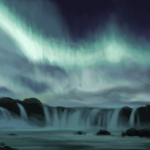I couldn’t let that last blog entry stand as my last statement on Winter 2014. I’ve been meaning to come back to music describing the seasons anyway. So why not end winter with some Miles Davis?
The quiet of winter does not have to be as terrifying as I so eloquently described it in my last blog. There is great power to be found in the stillness of winter and in the depths of our souls. When we allow ourselves to be silent, when we give ourselves permission to just sit with ourselves in the darkness and to face our fears, beautiful things can arrise. Ideas that were once hiddent, possibility that once seemed impossible or inconceiveable suddenly are within reach. Sometimes it takes going bravely into that darkness for the truly significant to be discovered in ourselves.
It was the final days of February, 1959. Miles Davis was finding Jazz to be increasingly complex, and at times even too difficult. Davis wanted to find a way to simplify Jazz without watering it down. For months he had been playing around with different musical structutres. Yet the more he thought about the changes he wanted, the more he struggled with the music.
Finally, he decided to just throw everything in the river, start from scratch, and just play.
For his album, Kind of Blue, Davis turned his back on the standard chord progression for composing and improvising jazz music, to instead create a new melodic structure. Rather than emphasize the chords and harmonies, he would simply emphasize the melody of the song. He wanted to emphasize cold spontanaeity from his musicians as opposed to laborious rehearsals. To help achieve this end, Davis conceived of the songs for this album only hours before the initial recording date. As well, the band (of specifically chosen and infinitely gifted players) wasn’t given sheet music to read. Rather Davis gave them musical sketches from which they all would improvise on the spot. They also would only get one take, two at best, to nail the songs. Anything more and the spontanaeity would be lost. Davis wanted no thought in the music. Just spirit.
This required all the musicians – even Davis, himself – to completely jump off the cliff of what was known and understood, into a world of where-the-heck-are-we-going? There was no room for doubt, no time for question or deliberation. There could be no disbelief in themselves or in eachother. They had to step off into the unknown and believe that they would all land safely.
In every way, this typifies the power of the winter silence. It can be scary to go into that unknown darkness and explore what and who we are. The voices in our heads can get in our way, scaring us away from our greatness. Yet when we courageously step forward into that darkness, we will find the light at the other side.
The album, Kind of Blue, not only changed Jazz, but music as a whole. By expanding the “space” within the music, Davis created an entirely new way of approaching improvisation within any music. Rock bands from The Grateful Dead to The Red Hot Chili Peppers site this album as a seminal influence in their musical development.
I play this CD not only for the silence and unknowing it offers, but also for the promise of inspiration and movement afterwards. When the voice inside my head is getting the best of me, making me depressed and sad, this album brings quiet and stillness to me. In that space, I am not afraid. I am at peace.

